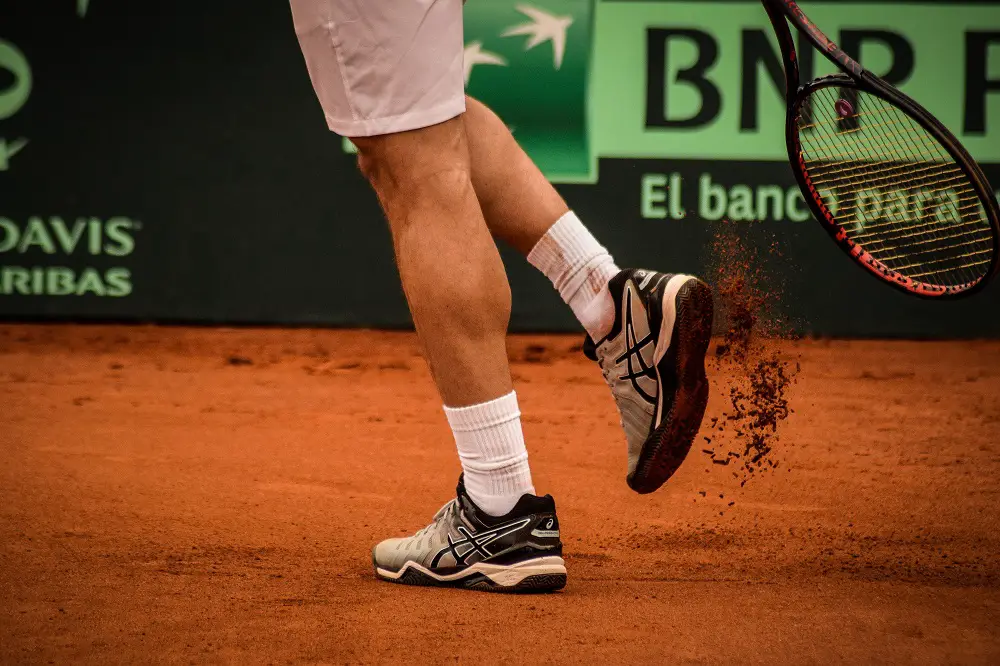What makes playing on clay so different and why do some tennis players struggle to transition to different surfaces? Jean-Yves Aubone, a former ATP player and current coach, explains this in his latest piece below.
The sliding. The angles. The drop shots. The long rallies. The court coverage. The fitness. The dirty socks.
The classic characteristics of a red clay court match.
But how does this type of tennis happen?
What is it about clay courts that bring about such an elegant type of show that we don’t see as much on other surfaces?
Why are there the so called “clay court specialists” that have most of their success on these courts, but cannot translate it into other surfaces?
And why do some players struggle to adapt to the type of game style required to succeed on the red clay?
Well, it all starts with the crushed brick, limestone, and gravel that constitutes the red clay court surface. This combination creates a slick sandy-like environment that allows a player to slide around the court.
For a player to maintain proper balance, and have just enough grip to stop, turn, and sprint in different directions, they need to use specific clay court soled shoes. Without them, they’d be slipping and falling all over the court. (as would player on wet courts for which we have a few wet-court shoe recommendations here)
Also Read:
Heck, that even happens now! Can you imagine without proper shoes?
Even with those special shoes, the slick sandy-like surface requires a player to have a strong lower body, and strong base. The surface exposes someone that struggles with their balance.
It exposes a player that never learns the ability to glide around the court, sliding to balls while maintaining a proper athletic position.
As soon as a player tips their upper body too far in any direction, the surface will punish them, causing them to slip. If they ignore the requirement to slide into balls, they’ll take multiple extra steps after they’ve hit a shot just to prevent themselves from slipping.
So even if they don’t fall to the ground, they’ll be slow to get to the next ball because they’re spending too much time trying to gather their balance.
The longer the rally goes, the farther and farther they’ll fall behind as they play more and more defense.
This doesn’t occur as much on a hard court though. It’s much easier to stop, change directions, and push off quickly because of the grittier surface. Someone who doesn’t have the best movement skills can get away with some inefficiencies.
On a clay court, those inefficiencies will show up right away.
The unique red clay court surface also creates a lot of resistance against a tennis ball, slowing the speed of a shot down dramatically more than what a hard court accomplishes.
Power is no longer a big advantage as their opponents have more time to hit the ball back. This leads to longer rallies. These long rallies force players to have strong legs and high levels of fitness, as they’ll be spending more time running and hitting balls.
Also Read:
Variety, shot placement, movement skills, and mental toughness are rewarded more than brute force.
Someone who can redirect balls around the court using well placed kick serves, drop shots and angles, causing their opponent to get off balance, and expose their weak physical or mental fitness levels, will be extremely successful.
Hard courts reward the brut force. They do not punish the lack of fitness, weak legs, and variety as much.
These types of courts don’t have such a dramatic impact on the ball. Shots don’t lose as much speed after making contact with the ground. Big serves and forehands are rewarded. Rallies are therefore shorter, requiring a lower level of fitness to be successful.
And for everyone that grew up on faster playing surfaces, that’s not a problem! Their game-styles and fitness levels were developed accordingly. They developed the quick yet powerful racket preparation technique, and explosive bursts of energy that are required for a short period of time.
But for the players that grew up on the slow grinding clay courts, it can be a difficult transition. They’re not used to being rushed by powerful shots. They’re not used to such a fast pace of play. They’re used to longer point structures, and developing favorable situations instead of forcing their way in.
They might not have developed the powerful serves or groundstrokes because they have placement and consistency.
They have longer racket preparations because they need to create more power to hit through the slow surface.
But the same can be said for the players that grew up on hard courts transitioning to playing on clay. They might not have the shot tolerance, variety, and fitness levels to succeed on the slower surface.
Their short racket preparations don’t create enough power to hit through the clay.
For each player, each surface has it’s own advantages and disadvantages. Depending on what surface they grew up on, and how their game developed, they’ll have a certain preference.
For us fans, we get to see different game styles succeed, and who can adjust to each surface the most. This is part of what makes tennis so much fun to watch.


